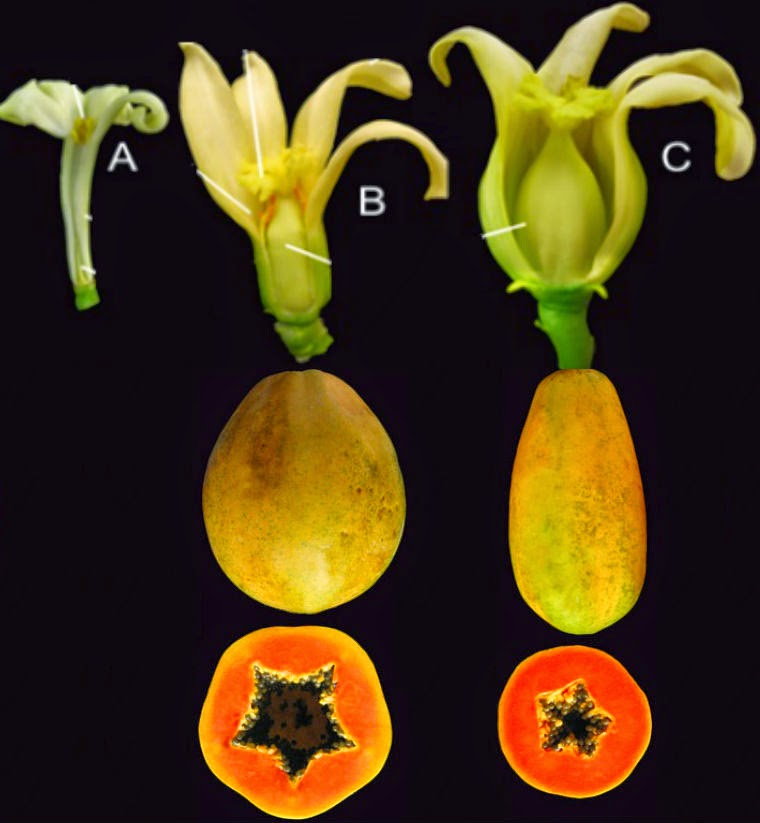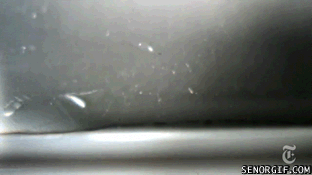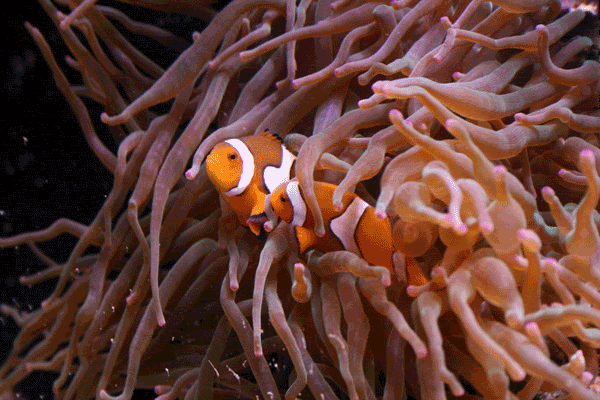Biology concepts – trioecy, sea anemone, sex determination systems, hermaphroditism, ecology, polyploidy
So, 94% of flowering plants are monoecious and the rest are some version of dioecious, right? Nope. A few exist stably in three morphs: male, female, and hermaphrodite. This makes them trioecious (tri = three, and oecious = house). The males and females can’t exist on their own, but could exist if it were just the two of them. The hermaphrodite could exist on its own, but it doesn’t. All three are present in a population and it stays that way. Stability of the three sex system is what separates trioecy from the transitional subdioecy we talked about last week.
It would be easy to mistake one of the dioecious breeding systems last week for trioecy depending on when you observed the population, and it has happened. In fact, most descriptions of trioecy have turned out to be dioecious populations in the midst of a switch of some kind (like heterodichogamous androdioecy), for example.
But some do exist. Atriplex canescens (the fourwinged saltbush) is a bush that lives in arid areas. Living in dry climates will be a recurring theme as we talk about trioecious plants. We have talked about this bush as an exception in the realm of polyploidy, and who knows, that may be involved in it being trioecious as well.
Saltbush has three different morphs of bushes, in terms of sex chromosomes and flowers; males, females and hermaphrodites. Trioecious it is; but this doesn’t mean that all the populations of saltbush are trioecious.
Add to this that fourwing saltbush can be diploid (2n) tetraploid (4n), or hexaploid (6n), and as we discussed previously, these different genotypes can be found in three different microenvironments. The hexaploid version is found in the driest areas, the 2n plants live closest to water and the 4n’s are in between.
This makes one wonder: could ploidy, environment and sexual breeding system be interrelated? A paper from way back in the 80’s looked at this very question. They found that the male:female ratios did vary according to ploidy, with diploid being about 1:1 and the tetraploid and hexaploid populations being more likely to have higher numbers of female plants.
Location also made a difference in number of each morph. Populations in more northern parts of the range were likely to have more male plants and fewer hermaphrodites. Two things jumped out at me. One, the authors didn’t address whether the location with respect to dryness. I would love to know if populations in the dry areas were more or less likely to be stably trioecious, or if the stress of being thirsty affects the female:male ratio.
Second, the authors looked at the sex ratios in the different ploidies. Everything seemed to follow a pure X/Y determination, except for the hermaphrodite plants. Since the sex determining genes for dioecious plants haven’t been determined yet, who can say what effect an XXXXXY, XXXXYY, or XXXYYY hexaploid might have on sex determination.
Papaya (Caricapapaya) is a trioecious plant and points out some the interesting aspects of studying plant breeding systems and sex determining genes. In fact, papaya may teach us about what makes males male and females female. The papaya females are XX, males are XY, but hermaphrodites have a slightly different Y, called Y(h).
Papaya grows as either dioecious or gynodioecious in cultivated fields because we plant them that way, but all three morphs exist. Why two ways to grow them? The fruit of the unisexual females is different from those of the hermaphrodite. Papain is an enzyme obtained only from papaya. It’s used as a meat tenderizer, to remove hair from hides before tanning, and to treat silk and wool before dyeing so that they will take up more color.
The seeds of the hermaphrodite fruit may be hermaphroditic or female (do the Punnet square, YY males are lethal). This presents a problem to papaya growers who only want to plant hermaphroditic seeds. Consumers are used to a certain look for their papayas, both in shape and color, so fruit growers want as many hermaphroditic plants and as few females as possible. In their opinion, females are just a waste of resources and time.
Farmers plant several seeds in each hole, and wait until the plants are old enough to tell the sexes apart (they flower). Then they cut down all the females and keep the hermaphrodites. This added time and effort costs money, time, and reduces the initial output of the hermaphrodite plants. What the growers need is a way to produce only hermaphrodite seeds.
It would be helpful if they could engineer seeds to be hermaphrodite, but to do this they first have to identify the sex determining genes on the sex chromosomes. This is especially important because we haven’t identified the sex determining genes in any dioecious plant, so this work would be important on two counts.
Sequencing of Y and Yh show that they have lots of chloroplast DNA. One, this shows that the hermaphrodite form is stable because the chloroplast DNA is degrading from the Yh very slowly.
Two, this shows that they are young – Yh is only about 4000 years old and is derived from the Y chromosome. This is about the time that human domesticated the papaya, so hermaphrodite fruits of this type are probably a result of domestication.
And three, parts of the Y chromosome don’t recombine during mitosis or meiosis. This points to the areas that are important for sex determination; the MSY (male specific region of Y) and HSY (hermaphrodite specific region of Y). So now they can look at just these regions. It turns out that that MSY and HSY are 99.6% identical. Any differences would be good candidates genes for the suppression of the female reproductive structures that creates male flowers from hermaphrodite flowers.
In fact, they found one gene called SVP (short vegetative phase) that is different between Y and Yh. The SVP in the HSY is truncated (shortened) as compared to the MSY version. The hypothesis is that the SVP suppresses the female ovule formation in the male, but the truncated version has lost function and this is why the hermaphrodite version allows for the formation of the female structures. Find out what genes SVP controls and you could then make all the seeds from hermaphrodite plants be hermaphroditic. No more need to weed out the females.
How about one more example of trioecy in plants? This one shows how the environment is important in determining which breeding system will win out. In a species of Sonoran cactus (Pachycereus pringlei), the population can exist as trioecous or gynodioecious. It is pollinated by the nectar-eating bat, Leptonycteris curasoae, but not all populations of P. pringlei live near a bat cave.
The unisexual plants do have an advantage, they produce 1.6-3.0x more pollen or seeds than the hermaphrodite plants; this is the only way they can compete with the perfect flowering plants. That’s O.K. for females, because they can be fertilized by either the hermaphrodites or the males, but the only way to make more unisexual males is for their pollen to get to females. What might account for their ability to survive in the population – bats.
Living near the bats provides much more opportunity for the unisexual males to be visited. Since they make more pollen then the perfect flowers, the increased number of pollinators is enough to put them over the hump and keep them successful enough to remain in those populations. But if the pollinators are too far away to give them a required number of visits, the males slowly die out and you end up with the gynodioecious populations.
A 2014 paper identified a trioecious animal, a sea anemone. Aiptasia diaphanais a cnidarian, as are all sea anemones. You would recognize them from Looking for Nemo; clownfish like Nemo and his dad live inside the tentacles of a sea anemone. They are immune to the venom in the anemone nematocysts, while other small fish would be stung, killed, and eaten.
Most animals have males and females. There are rare animal species that exist as only females (those that undergo parthenogenesis). Some animals exist as hermaphrodites, but A. diaphana is the first animal shown to exist as all three – males, females, and hermaphrodites in a single population.
The researcher in this study collected the propagules (asexual offspring) and allowed them to grow up. They then examined the sex chromosomes and sex steroid levels and determined that some were guys, some were girls, and some were hermaphrodites. Maybe studying plants can help us with animal research after all.
Next week, we've talked enough about the dimorphisms in plants. Back to the animal world with some of the most amazing exceptions to bilateral symmetry; their exactly half male and half female.
Next week, we've talked enough about the dimorphisms in plants. Back to the animal world with some of the most amazing exceptions to bilateral symmetry; their exactly half male and half female.
Ueno, H., Urasaki, N., Natsume, S., Yoshida, K., Tarora, K., Shudo, A., Terauchi, R., & Matsumura, H. (2014). Genome sequence comparison reveals a candidate gene involved in male–hermaphrodite differentiation in papaya (Carica papaya) trees Molecular Genetics and Genomics, 290 (2), 661-670 DOI: 10.1007/s00438-014-0955-9
Sorry, I tried to find more information or classroom activities for trioecy, but there isn't much out there.





